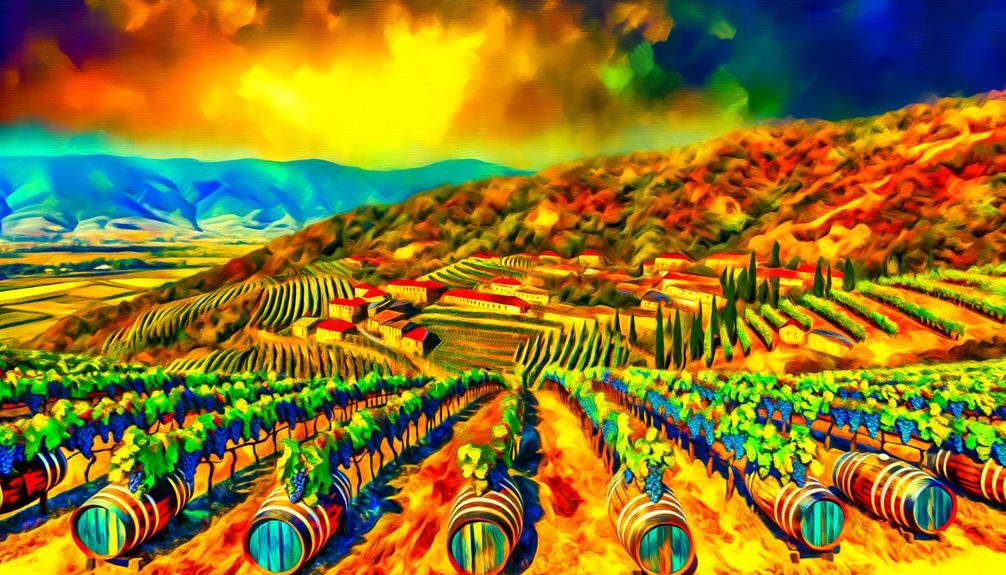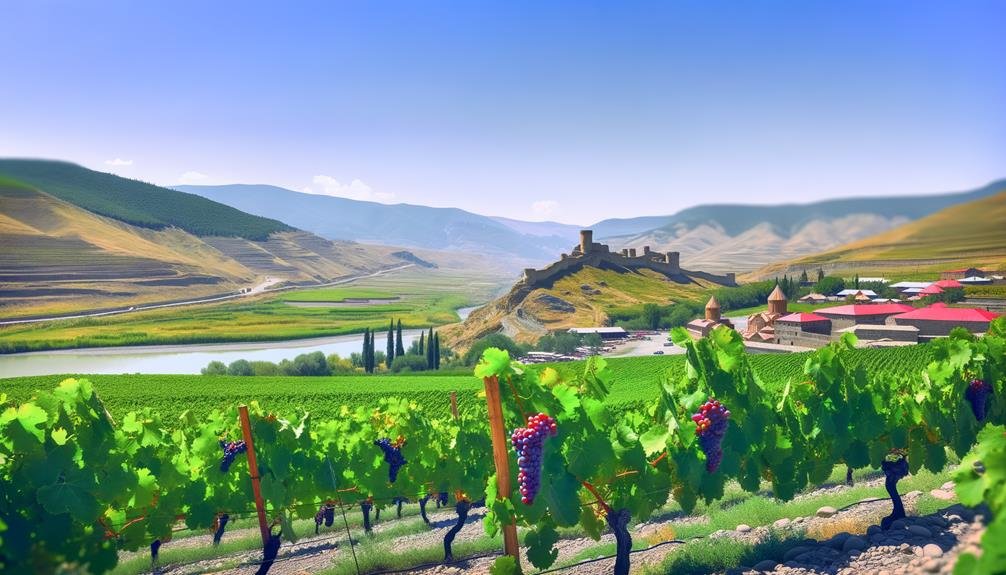The Caucasus region, spanning Georgia, Armenia, and Turkey, boasts a diverse selection of grape varieties that showcase the unique terroirs and rich winemaking traditions of the area.
From Georgia's bold Saperavi and delicate Rkatsiteli to Armenia's refined Areni and Voskehat, and Turkey's intriguing Boğazkere and Emir, each grape variety carries with it a story of centuries-old practices and careful cultivation.
These lesser-known grapes provide wine enthusiasts with an exceptional tasting experience, inviting them to delve into the historical and cultural significance intertwined with each bottle.
What sets these grapes apart, and how do they shape modern viticulture in the region?
Indigenous Grapes of the Caucasus

The Caucasus region boasts a wide range of unique grape varieties that play a vital role in its diverse winemaking traditions. Varieties like Areni, Khndoghni, Voskehat, Goruli Mtsvane, Rkatsiteli, Saperavi, Usakhelouri, Boğazkere, Emir, and Öküzgözü offer distinct flavors and characteristics.
These grapes, cultivated using a blend of ancient and modern techniques, are gaining recognition worldwide for their exceptional quality. Winemakers in the Caucasus combine traditional and modern methods to create wines with unique and innovative flavors. This fusion not only honors the region's cultural heritage but also appeals to contemporary wine enthusiasts seeking authentic and original experiences.
Exploring these indigenous grape varieties reveals the Caucasus's significant contribution to the global wine industry.
Wines From Georgia
Georgia's winemaking heritage is deeply rooted in its indigenous grape varieties, making it a standout in the Caucasus region. With a history that spans over 8,000 years, the country's winemaking traditions are a blend of ancient practices and innovative techniques.
One of Georgia's renowned methods is the Qvevri technique, which involves using clay vessels buried underground to create wines with distinctive flavors.
One of the notable grape varieties in Georgia is Saperavi, a red grape that produces full-bodied wines with rich color and complexity. Rkatsiteli, on the other hand, is a versatile white grape known for its crisp acidity and floral notes.
Usakhelouri is a rare red grape variety that offers sweet, aromatic wines with a unique character, while Goruli Mtsvane is a green-skinned grape that yields fresh, aromatic white wines with a touch of spice.
These indigenous grape varieties contribute to the diversity and richness of Georgian wines, showcasing the country's unique winemaking heritage.
Through the use of traditional methods like the Qvevri technique and a focus on indigenous grapes, Georgia continues to produce wines that are both distinctive and memorable.
Armenian Wine Heritage

Armenia's wine heritage reflects its deep cultural and historical roots amidst the rugged landscapes and ancient monasteries. With a winemaking tradition spanning over 6,000 years, the country boasts indigenous grape varieties like Areni and Voskehat that hold significant importance. Areni, known as the 'king of Armenian grapes,' is esteemed for its robustness and capacity to produce complex, long-lasting wines.
On the other hand, Voskehat, referred to as the 'queen of Armenian grapes,' contributes a distinctive aromatic character, enhancing the diversity of Armenian wines.
Contemporary Armenian wineries, such as Zorah Wines, are blending traditional winemaking techniques with innovative approaches, garnering praise on the global stage. This blend of old and new exemplifies Armenia's dynamic presence in the international wine scene, showcasing its unique contributions and rich heritage.
The fusion of ancient grape varieties with modern winemaking practices not only preserves tradition but also propels Armenia forward as a notable player in the evolving world of wine.
Turkish Wine Varieties
Turkey's wine scene is a treasure trove of unique grape varieties and diverse winemaking traditions, drawing inspiration from the Caucasus region.
Among the standout local grapes are Boğazkere, Kalecik Karası, Emir, and Öküzgözü, each contributing its own distinctive flavors to Turkey's wine landscape.
Boğazkere stands out for its robust tannins and deep fruit notes, often likened to the richness of Cabernet Sauvignon. On the other hand, Kalecik Karası offers a lighter, aromatic profile with hints of red berries, reminiscent of the delicate nature of Pinot Noir.
Emir, a white grape, produces refreshing wines with a pronounced mineral character, perfect for the warm climates of Turkey. Lastly, Öküzgözü is celebrated for its harmonious acidity and luscious fruit flavors, making it a versatile choice for a variety of wine styles.
These indigenous grape varieties not only enhance Turkey's wine culture but also cater to the evolving tastes of wine enthusiasts worldwide, offering a unique and compelling exploration of the country's winemaking heritage.
Exploring Lesser-Known Regions

Exploring the lesser-known wine regions of the Caucasus unveils a fascinating world of ancient traditions and unique grape varieties waiting to be explored. These regions, which include Armenia, Azerbaijan, Iran, and Russia, offer an exceptional opportunity for wine enthusiasts to discover new tastes and experiences.
With diverse climates and terroirs, a range of indigenous grapes like Khndoghni and Usakhelouri thrive, each offering distinct flavors to savor. Delving into these areas allows enthusiasts to uncover age-old winemaking methods, such as the traditional Georgian Qvevri technique, blending history with innovation.
Dr. Matthew Horkey and Charine Tan, wine explorers, emphasize the importance of these hidden gems, encouraging wine lovers to expand their horizons beyond mainstream varietals.
Global Popularity of Caucasus Wines
As wine lovers increasingly look for unique and authentic experiences, the wines from the Caucasus region are gaining worldwide acclaim for their exceptional quality and diverse range of flavors. This growing popularity can be attributed to a few key factors that set these wines apart:
The Caucasus region boasts a rich history and deep-rooted winemaking traditions, such as Georgia's Qvevri technique, which contribute to the unique character and authenticity of its wines. These ancient methods add a special touch that appeals to discerning wine enthusiasts seeking something different.
One of the region's strengths lies in its indigenous grape varieties like Saperavi and Areni, which offer distinctive flavors that captivate a global audience. These unique grapes bring a fresh and exciting taste profile to the wine scene, making Caucasus wines stand out among the crowd.
Thanks to a combination of modern winemaking techniques and respect for traditional practices, the quality of Caucasus wines has reached new heights. This blend of innovation and heritage ensures that each bottle delivers a premium drinking experience that satisfies even the most sophisticated palates.
Furthermore, with an increase in distribution channels, Caucasus wines are now more accessible to international markets, allowing wine enthusiasts worldwide to discover and enjoy these hidden gems. This growing availability has fueled the surge in popularity and recognition of the region's winemaking prowess on a global scale.
Tasting Unique Flavors

Exploring the unique flavors of wines from the Caucasus region reveals a diverse range of taste experiences that highlight the area's rich cultural and winemaking history.
The local grape varieties like Saperavi, Rkatsiteli, and Areni offer intriguing and satisfying flavor profiles. Saperavi, a bold red grape hailing from Georgia, brings intense tannins and notes of dark fruits to the palate.
In contrast, Armenian Areni presents a lighter yet intricate blend of red berries and spices. Rkatsiteli, a versatile grape, yields both dry and semi-sweet wines with a refreshing acidity and floral scents.
These distinctive flavors mirror the varied terroirs of the Caucasus, providing an exciting playground for wine lovers eager to delve into something beyond the ordinary.
Historical Winemaking Traditions
The winemaking traditions in the Caucasus region have been practiced for thousands of years, with techniques like Georgia's UNESCO-recognized Qvevri method playing a vital role in preserving the region's viticultural heritage. These ancient methods, handed down through generations, ensure that the wines produced in this region are truly authentic and unique.
What sets these traditional practices apart is not just their age, but their ability to impart distinctive flavors and characteristics to the wines that modern techniques often fail to replicate. The Qvevri winemaking technique involves using large clay vessels that are buried underground for fermentation and storage, resulting in wines with a special depth and complexity.
Armenia's use of the ancient Areni grape, one of the oldest known grape varieties, is a testament to the rich winemaking history of the region. In Turkey, techniques dating back centuries are still employed in regions like Cappadocia, showcasing the enduring legacy of winemaking in the area.
Beyond the technical aspects, winemaking holds deep cultural significance in the Caucasus, deeply intertwined with local customs and traditions. By preserving these time-honored practices while also embracing innovation, the Caucasus region demonstrates a profound commitment to honoring its winemaking legacy.
Through the melding of tradition and progress, the region continues to produce wines that are not only steeped in history but also offer a unique and unforgettable taste experience for wine enthusiasts worldwide.
Impact of Politics on Wine

The political landscape in the Caucasus region significantly impacts the wine production industry, presenting both challenges and opportunities for local winemakers. Ongoing conflicts like the Armenia-Azerbaijan dispute and Georgia's border tensions have disrupted vineyard operations and supply chains, resulting in inconsistent production levels and restricted market access. Despite these obstacles, winemakers in the region have shown resilience and innovation in preserving their heritage and adapting to the ever-changing political climate.
The political complexities in the Caucasus have led winemakers to explore new techniques and methods to maintain the quality and uniqueness of their wines. In response to these challenges, government initiatives promoting wine tourism and offering export incentives have been crucial in supporting industry growth and expansion. These efforts not only help in overcoming geopolitical hurdles but also contribute to elevating the global reputation of Caucasus wines.
Despite the disruptions caused by political conflicts, the Caucasus region continues to offer a rich and diverse wine tasting experience rooted in centuries-old traditions. The dedication and ingenuity of local winemakers shine through as they navigate the complexities of geopolitics to showcase their exceptional wines to the world. By embracing innovation and preserving their heritage, Caucasus winemakers are carving a distinct place in the global wine market, captivating wine enthusiasts with their unique flavors and stories.
Trends in the Wine Market
In the dynamic global wine market, the unique wines from the Caucasus region are influencing current trends and consumer preferences significantly. These wines are gaining popularity due to their authenticity, heritage, and distinctive characteristics that set them apart from mainstream options.
Consumers are increasingly seeking wines with a rich historical background and deep-rooted traditions, which the wines from the Caucasus region deliver. This connection to the past adds value to the overall experience of enjoying these exceptional wines.
Moreover, the region's commitment to sustainable winemaking practices resonates with eco-conscious consumers who prioritize environmental responsibility. By blending ancient techniques with modern sustainability standards, winemakers in the Caucasus region are meeting the demand for ethically produced wines.
The diverse flavor profiles of indigenous grape varieties from the Caucasus region offer a delightful departure from the familiar tastes found in mass-produced wines. This uniqueness appeals to consumers looking for new and exciting flavors to explore.
Furthermore, the increasing popularity of wine tourism in the Caucasus is providing enthusiasts with firsthand experiences that deepen their appreciation for these exceptional wines. By immersing themselves in the culture and landscape where the wines are produced, consumers develop a deeper connection to the product.
Conclusion
The Caucasus region boasts a diverse array of unique grape varieties that reflect a long history of winemaking and the influence of different terroirs. These grapes not only offer distinctive flavors but also carry deep cultural significance, making each bottle a symbol of the region's heritage.
Amidst changing political landscapes and evolving market trends, the wine industry in the Caucasus continues to adapt and thrive, showcasing the dynamic nature of the region's viticulture.
By savoring these wines, one can truly connect with the historical and cultural fabric of Georgia, Armenia, and Turkey, gaining a deeper appreciation for the traditions that have shaped these wines for centuries.